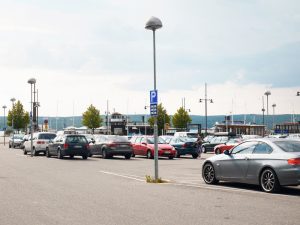No Parking? No Problem – Here’s How Park & Rides Can Help Your Business
In today’s bustling urban environments, businesses are constantly seeking innovative ways to enhance productivity, reduce overhead costs, and contribute to sustainable community development. One often overlooked but highly effective strategy is the utilization of park and ride facilities. These hubs, designed to encourage carpooling, public transit use, and biking or walking, offer a myriad of benefits to businesses, employees, and the broader community. Here’s how park and rides can transform your business operations and contribute to a more sustainable and efficient future.

Source: Shutterstock.com/Brandon Gray
Enhancing Employee Productivity and Well-being
One of the primary advantages of park and rides is their potential to improve employee productivity and well-being. Commuting is a significant source of stress for many employees, with traffic congestion and long travel times leading to decreased morale and increased absenteeism. By providing park and ride facilities, businesses can offer their employees a more convenient and less stressful commute. Even if your employees have never used a park and ride before, they can view a park and ride ultimate guide to get familiar before they start their commute.
Carpooling
Carpooling is a major component of park and ride systems. By encouraging employees to share rides, businesses can help reduce the number of vehicles on the road, leading to shorter travel times and less stress for commuters. Carpooling also fosters a sense of community among employees, potentially leading to improved teamwork and communication in the workplace.
Moreover, carpooling can lead to significant cost savings for employees. Reduced fuel and maintenance costs make carpooling an attractive option, which in turn can improve overall job satisfaction and retention rates. Happier, more satisfied employees are typically more productive and engaged, directly benefiting the business. Plus, there’s a variety of carpool rewards available for commuters who opt to leave their single-occupancy vehicle at home and join a group ride.
Public Transit
Integrating park and rides with public transit systems can further enhance employee commutes. Employees can park their cars at designated locations and take buses or trains for the remainder of their journey. This hybrid approach can significantly reduce travel times, especially in urban areas where traffic congestion is a major issue.
Public transit is also more predictable than driving, with scheduled stops and dedicated lanes in some cities, leading to fewer delays and a more reliable commute. This reliability can translate into employees arriving at work on time and less frazzled, ready to start their day on a positive note. Encouraging your employees to utilize park and rides is one of the most effective commuter solutions available. On top of that, providing your employees alternative solutions to arriving to work is a great way to show them that you care about their well-being.
Biking and Walking
For those employees who live closer to their workplaces, park and rides can also support biking and walking. Businesses can provide secure bike storage, bike repair stations and even shower facilities to encourage this mode of commuting. Biking and walking offer numerous health benefits, including improved cardiovascular health and reduced stress levels, which can contribute to a more energetic and productive workforce.

Shutterstock.com/an_graphic_designer
Cost Savings for Businesses
Beyond improving employee well-being and productivity, park and rides can lead to significant cost savings for businesses. By reducing the need for large on-site parking facilities, businesses can save on construction, maintenance, and land costs. These savings can then be redirected towards other strategic initiatives or investments.
Reduced Parking Demand
Implementing park and ride systems reduces the overall demand for on-site parking. This is particularly beneficial for businesses located in urban centers where parking space is at a premium and costs are high. Fewer cars parked on-site also means lower maintenance costs, including lighting, security, and repairs.
Tax Incentives and Grants
Many governments offer tax incentives and grants to businesses that promote sustainable commuting practices. By investing in park and ride facilities and encouraging carpooling, public transit use, and biking or walking, your business can take advantage of these financial incentives. This not only reduces operational costs but also positions your business as a leader in corporate social responsibility!
Environmental Benefits and Corporate Responsibility
In today’s environmentally conscious world, businesses are increasingly expected to adopt sustainable practices. Park and ride facilities can play a significant role in reducing a business’s carbon footprint and demonstrating a commitment to environmental stewardship.
Reduced Emissions
By facilitating carpooling and public transit use, park and rides help reduce the number of vehicles on the road, leading to lower greenhouse gas emissions and improved air quality. This reduction in emissions aligns with global efforts to combat climate change and can enhance a business’s reputation among environmentally conscious consumers and stakeholders.

Source: Shutterstock.com/Andrii Nekrasov
Promoting Sustainability
Encouraging biking and walking further supports a business’s sustainability goals. These zero-emission modes of transportation contribute to cleaner air and reduced traffic congestion. Businesses that promote these practices can enhance their brand image as environmentally responsible and attract customers and employees who value sustainability.
Strengthening Community Relations
Park and ride facilities not only benefit businesses and employees but also the broader community. By reducing traffic congestion and improving air quality, these facilities contribute to a higher quality of life for all residents. Businesses that support park and ride initiatives can build stronger relationships with their communities and demonstrate a commitment to local development.
Community Engagement
Businesses can partner with local governments and organizations to develop and promote park and ride facilities. This collaboration can lead to increased community engagement and positive publicity. By investing in local infrastructure, businesses show that they are committed to the well-being of the community, which can enhance their standing and foster goodwill.
Economic Growth
Improved transportation options can also stimulate local economic growth. Easier commutes can attract more visitors and customers to the area, benefiting local businesses and services. Additionally, reduced traffic congestion can make the area more attractive to new businesses and residents, further boosting the local economy.
The Bottom Line
Park and ride facilities offer a multifaceted solution to some of the most pressing challenges faced by businesses today. By promoting carpooling, public transit, and biking or walking, these facilities can enhance employee productivity and well-being, lead to significant cost savings, reduce environmental impact, and strengthen community relations. Investing in park and ride systems represents a strategic move that can yield substantial benefits for both the business and the broader community. Embracing this approach is not only a step towards a more sustainable future but also a smart business decision that can drive growth and success in the years to come.
